Skoltech researchers have identified promising ceramic materials for metal coatings that would boost gas turbine efficiency. If further experimental tests prove successful, the coatings will enable power plants to produce more electricity and jet planes to consume less fuel. Meanwhile, with the material discovery technique tried and tested, the researchers intend to continue the search and find more candidates with perhaps even better properties. The study came out in Physical Review Materials.
Thermal barrier coatings are used to protect turbine blades at power plants and in jet engines. The blades themselves are made of nickel-based superalloys. These offer a great combination of high-temperature strength, toughness, and resistance to degradation. However, as things get really hot, the superalloy softens and may even melt. Protective coatings make it possible to operate turbines at higher temperatures without compromising their integrity. And in this case, higher temperature means greater efficiency.
“Thermal barrier coatings are nowadays made of yttria-stabilized zirconia, but if a material with better properties were used instead, that would allow you to get more useful power out of the turbine,” says study co-author Professor Artem R. Oganov, who heads the Material Discovery Laboratory at Skoltech. “To find such materials, you first have to come up with candidates whose properties you predict computationally. We have tested a range of methods and determined the best of them for calculating the relevant material properties, particularly thermal conductivity. In the paper, we list some promising candidates, and we’ll keep on looking.”
A material for thermal barrier coatings has to meet several requirements. It must have a very high melting point and a very low thermal conductivity. The latter property is particularly hard to compute because it depends on the intricate “anharmonic” effects in crystals. Also, when heated, the material should expand at about the same rate as the superalloy, or else it will flake off the surface. The material should not undergo any phase transitions between room temperature and the operating temperature of the turbine, which would cause the coating to crack. It should also withstand the effects of dust particles and oxygen at high temperatures and prevent oxygen ions from reaching the underlying metal and oxidizing it.
“While we did calculate the other properties, the crux of the problem is predicting thermal conductivity,” says study co-author, Skoltech PhD student Majid Zeraati. “We showed such predictions are computationally feasible and reasonably accurate with homogeneous nonequilibrium molecular dynamics simulations. This proves somewhat unexpected, as such simulations involve a massive amount of computations and extensive statistics, resulting in high computational complexity. Nevertheless, we managed to simplify the method by supplementing it with machine learning potentials: That is, the interactions between the atoms were predicted using artificial intelligence, rather than being directly calculated.”
The Skoltech study already highlights a number of materials that promise to surpass yttria-stabilized zirconia, the current champion. Among them are yttrium niobate (Y3NbO7), the perovskite structures BaLaMgTaO6 and BaLaMgNbO6, and seven more materials. That said, the team plans to continue its computational search to identify possible backup options and the potentially better candidates still out there.
The study reported in this story was supported by Russian Science Foundation Grant Nos. 23-13-00117 and 19-72-30043.
Contact information:
Skoltech Communications
+7 (495) 280 14 81

